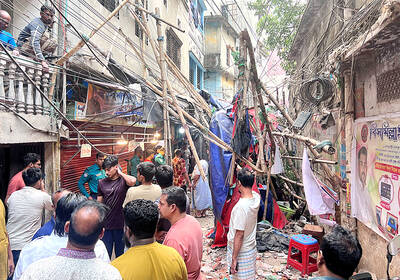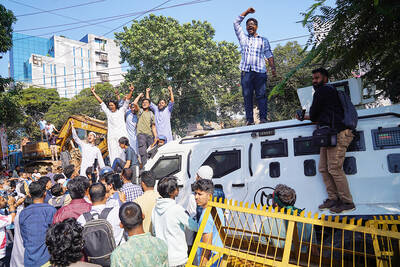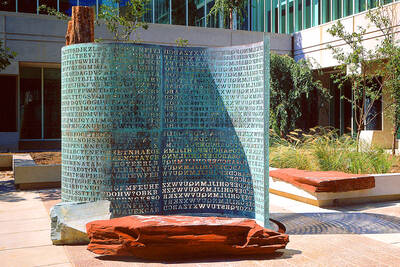Legendary photographer Henri Cartier-Bresson, who traveled the world for more than a half-century capturing human drama with his camera, has died, the French Cul-ture Ministry said. He was 95.
Cartier-Bresson shot for Life, Vogue and Harper's Bazaar and his work inspired generations of photographers. Cartier-Bresson became a French national treasure, though he was famously averse to having his own picture taken or to giving interviews.

PHOTO: REUTERS
A statement from his family and the Magnum photo agency, which Cartier-Bresson co-founded, said he died on Tuesday and a private funeral was held on Wednesday.
Paul Bruton, a Magnum spokes-man, said he had died at home in Cereste in southeastern France, and was buried in the nearby Alpes-de-Haute-Provence region.
French President Jacques Chirac said: "With him, France loses a genius photographer, a true master and one of the most gifted artists of his generation and most respected in the world."
Whether recording the funeral of Mahatma Gandhi in India or Henri Matisse at home, Cartier-Bresson sought to render the feeling of the moment with his distinctive classical style and penchant for geometrical composition.
"In whatever one does, there must be a relationship between the eye and the heart," he once said in a rare interview. "With the one eye that is closed, one looks within; with the other eye that is open, one looks without."
His photography centered on what he described as "the decisive moment" evoking the significance of a given situation as all the external elements fall into place.
Cartier-Bresson worked only with black-and-white film and without a flash. Thrusting a subject in the limelight, he once said, was a sure way to destroy it.
While most of his international fame was generated from worldwide exhibitions and publications, Cartier-Bresson gained recognition from two documentary films he made, one about medical aid to the loyalists in the Spanish Civil War and the other about French prisoners of war returning home at the end of World War II.
Cartier-Bresson was born Aug. 22, 1908, in Chanteloup outside Paris to a wealthy textile family. At 20, he turned his back on the family business to study painting. He had his first exhibitions in Madrid and New York in 1933.
At the outbreak of World War II, he was drafted into the French army, where he was captured in June 1940. After nearly three years in German prison camps, Cartier-Bresson escaped and returned to Paris, where he transported ex-prisoners for the underground.
In the last 25 years of his life, Cartier-Bresson largely turned away from photography to embrace his first love, painting.

DISASTER: The Bangladesh Meteorological Department recorded a magnitude 5.7 and tremors reached as far as Kolkata, India, more than 300km away from the epicenter A powerful earthquake struck Bangladesh yesterday outside the crowded capital, Dhaka, killing at least five people and injuring about a hundred, the government said. The magnitude 5.5 quake struck at 10:38am near Narsingdi, Bangladesh, about 33km from Dhaka, the US Geological Survey (USGS) said. The earthquake sparked fear and chaos with many in the Muslim-majority nation of 170 million people at home on their day off. AFP reporters in Dhaka said they saw people weeping in the streets while others appeared shocked. Bangladesh Interim Leader Muhammad Yunus expressed his “deep shock and sorrow over the news of casualties in various districts.” At least five people,

LEFT AND RIGHT: Battling anti-incumbent, anticommunist sentiment, Jeanette Jara had a precarious lead over far-right Jose Antonio Kast as they look to the Dec. 14 run Leftist candidate Jeannette Jara and far-right leader Jose Antonio Kast are to go head-to-head in Chile’s presidential runoff after topping Sunday’s first round of voting in an election dominated by fears of violent crime. With 99 percent of the results counted, Jara, a 51-year-old communist running on behalf of an eight-party coalition, won 26.85 percent, compared with 23.93 percent for Kast, the Servel electoral service said. The election was dominated by deep concern over a surge in murders, kidnappings and extortion widely blamed on foreign crime gangs. Kast, 59, has vowed to build walls, fences and trenches along Chile’s border with Bolivia to

DEATH SENTENCE: The ousted leader said she was willing to attend a fresh trial outside Bangladesh where the ruling would not be a ‘foregone conclusion’ Bangladesh’s fugitive former prime minister Sheikh Hasina yesterday called the guilty verdict and death sentence in her crimes against humanity trial “biased and politically motivated.” Hasina, 78, defied court orders that she return from India to attend her trial about whether she ordered a deadly crackdown against the student-led uprising that ousted her. She was found guilty and sentenced to death earlier yesterday. “The verdicts announced against me have been made by a rigged tribunal established and presided over by an unelected government with no democratic mandate,” Hasina said in a statement issued from hiding in India. “They are biased and politically motivated,” she

It is one of the world’s most famous unsolved codes whose answer could sell for a fortune — but two US friends say they have already found the secret hidden by Kryptos. The S-shaped copper sculpture has baffled cryptography enthusiasts since its 1990 installation on the grounds of the CIA headquarters in Virginia, with three of its four messages deciphered so far. Yet K4, the final passage, has kept codebreakers scratching their heads. Sculptor Jim Sanborn, 80, has been so overwhelmed by guesses that he started charging US$50 for each response. Sanborn in August announced he would auction the 97-character solution to K4